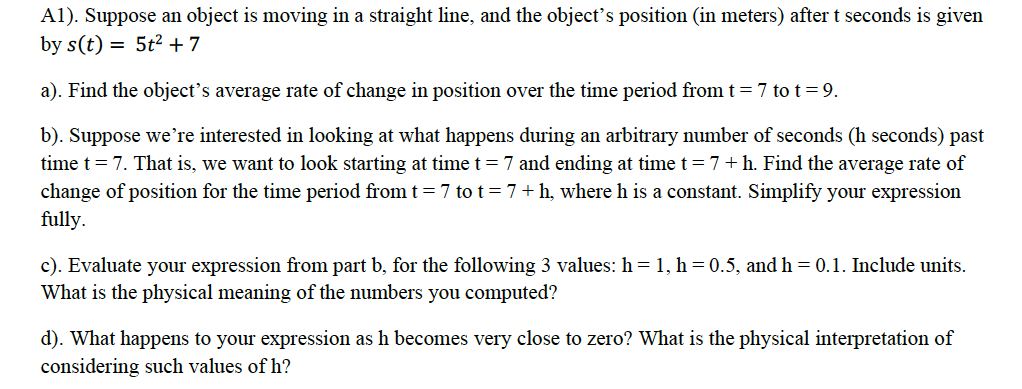A1). Suppose an object is moving in a straight line, and the object's position (in meters) after t seconds is given by s(t) = 5t² + 7 a). Find the object's average rate of change in position over the time period from t=7 to t=9. b). Suppose we’re interested in looking at what happens during an arbitrary number of seconds (h seconds) past time t = 7. That is, we want to look starting at time t = 7 and ending at timet=7+h. Find the average rate of change of position for the time period from t = 7 to t= 7+ h, where h is a constant. Simplify your expression fully. c). Evaluate your expression from part b, for the following 3 values: h=1, h = 0.5, and h = 0.1. Include units. What is the physical meaning of the numbers you computed? d). What happens to your expression as h becomes very close to zero? What is the physical interpretation of considering such values of h?
A1). Suppose an object is moving in a straight line, and the object's position (in meters) after t seconds is given by s(t) = 5t² + 7 a). Find the object's average rate of change in position over the time period from t=7 to t=9. b). Suppose we’re interested in looking at what happens during an arbitrary number of seconds (h seconds) past time t = 7. That is, we want to look starting at time t = 7 and ending at timet=7+h. Find the average rate of change of position for the time period from t = 7 to t= 7+ h, where h is a constant. Simplify your expression fully. c). Evaluate your expression from part b, for the following 3 values: h=1, h = 0.5, and h = 0.1. Include units. What is the physical meaning of the numbers you computed? d). What happens to your expression as h becomes very close to zero? What is the physical interpretation of considering such values of h?
College Physics
10th Edition
ISBN:9781285737027
Author:Raymond A. Serway, Chris Vuille
Publisher:Raymond A. Serway, Chris Vuille
Chapter2: Motion In One Dimension
Section: Chapter Questions
Problem 74AP: A glider on an air track carries a flag of length through a stationary photogate, which measures...
Related questions
Question

Transcribed Image Text:A1). Suppose an object is moving in a straight line, and the object's position (in meters) after t seconds is given
by s(t) = 5t2 +7
a). Find the object's average rate of change in position over the time period from t = 7 to t=9.
b). Suppose we're interested in looking at what happens during an arbitrary number of seconds (h seconds) past
time t = 7. That is, we want to look starting at time t = 7 and ending at time t=7+h. Find the average rate of
change of position for the time period from t= 7 tot=7+h, where h is a constant. Simplify your expression
fully.
c). Evaluate your expression from part b, for the following 3 values: h = 1, h = 0.5, and h= 0.1. Include units.
What is the physical meaning of the numbers you computed?
d). What happens to your expression as h becomes very close to zero? What is the physical interpretation of
considering such values of h?
Expert Solution
This question has been solved!
Explore an expertly crafted, step-by-step solution for a thorough understanding of key concepts.
Step by step
Solved in 5 steps

Knowledge Booster
Learn more about
Need a deep-dive on the concept behind this application? Look no further. Learn more about this topic, physics and related others by exploring similar questions and additional content below.Recommended textbooks for you

College Physics
Physics
ISBN:
9781285737027
Author:
Raymond A. Serway, Chris Vuille
Publisher:
Cengage Learning

Physics for Scientists and Engineers: Foundations…
Physics
ISBN:
9781133939146
Author:
Katz, Debora M.
Publisher:
Cengage Learning

College Physics
Physics
ISBN:
9781938168000
Author:
Paul Peter Urone, Roger Hinrichs
Publisher:
OpenStax College

College Physics
Physics
ISBN:
9781285737027
Author:
Raymond A. Serway, Chris Vuille
Publisher:
Cengage Learning

Physics for Scientists and Engineers: Foundations…
Physics
ISBN:
9781133939146
Author:
Katz, Debora M.
Publisher:
Cengage Learning

College Physics
Physics
ISBN:
9781938168000
Author:
Paul Peter Urone, Roger Hinrichs
Publisher:
OpenStax College